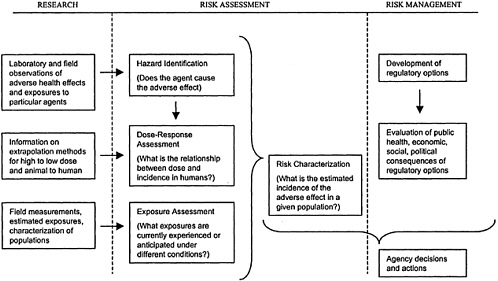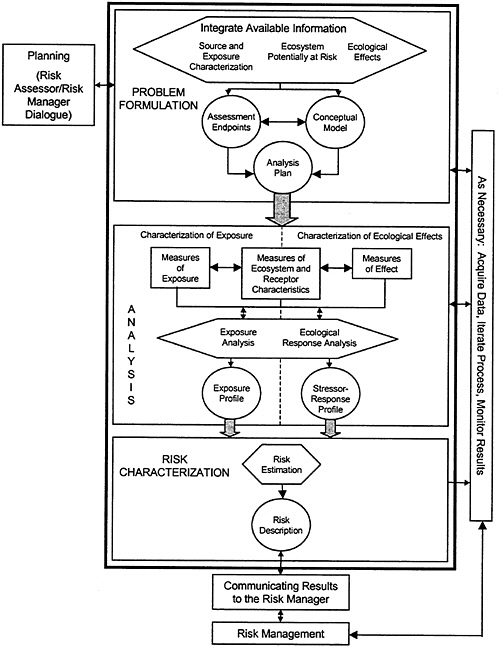3
The Framework
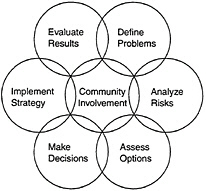
Each PCB-contaminated site is unique in terms of level and extent of contamination, the types of communities and ecosystems that are located near or affected by the site, the site history, the effects of the contamination on human and ecological health, and the applicable regulations. During the public sessions held by the committee, it became apparent that the processes used by the regulatory agencies, such as EPA and state environmental agencies, and by the industries—generally termed potentially responsible parties at Superfund sites—to deal with each site were neither uniform and consistent nor clear to outside parties. At present, the approaches appear to vary considerably from site to site or even at specific locations within a larger site. Data collection, applicable models, and interpretation of the results were not always presented in a manner to make the risks at a site, particularly the relative risks of alternative actions at a site, evident to all. The processes used by the federal and state agencies responsible for remediating contaminated sites should be broadened to address some of the concerns raised during the public sessions. EPA’s development of the Contaminated Sediment Management Strategy (EPA 1998a) and Remediation Guidance Document for Contaminated Sediments (in preparation) will, over time, assist in managing risks at contaminated sediment sites in a more consistent manner. The available EPA strategy document, however, provides only the broad principles that should guide agency response to contaminated sediment sites. In addition, the second goal of the EPA strategy is
to reduce the volume of existing contaminated sediment, a goal that does not necessarily reduce risk.
Therefore, in consideration of what the committee heard during the public sessions, particularly with respect to the need for a collaborative and iterative process to manage a broad range of risk, the committee determined that a framework was necessary to provide a consistent structure to assess the risks from PCB contamination and the risks associated with the various technologies and options that might be used to clean up a site. The framework should be risk-based and applicable to a variety of sites, where risks can range from obvious and short term to less evident and decades long. The framework should also be able to build upon many of the methods and procedures developed by the regulatory agencies, but it should go beyond the traditional human-health and ecological risk-assessment processes, such as those in the EPA’s Risk Assessment Guidance for Superfund (RAGS) (EPA 1989).
As discussed in Chapter 1, the Committee on Remediation of PCB-Contaminated Sediments was given the task of selecting and refining such a scientific risk-based framework for assessing the remediation alternatives for exposure of humans and other organisms to PCBs in contaminated sediments.
RISK-MANAGEMENT FRAMEWORK
PCB-contaminated sediments threaten ecosystems, marine resources, and human health and can have significant impacts on affected communities. Any decision regarding the specific choice of a risk management strategy for a contaminated sediment site must be based on careful consideration of the advantages and disadvantages of available options and a balancing of the various risks, costs, and benefits associated with each option.
The committee appreciates that more than one risk-assessment and risk-management framework has been developed and can be effective in assessing and managing a variety of activities (e.g., NRC 1983, 1994, 1996; EPA 1998b, 1999). Furthermore, some of these assessment procedures are mandated by various laws and regulations. The committee reviewed several of these frameworks and found that, although useful for specific situations, generally they are not applicable to the variety of sites and situations where PCB-contaminated sediments are an issue. One of the earliest risk-assessment frameworks was that developed by the National Research Council (NRC) in 1983 in Risk Assessment in the Federal Government: Managing the Process. This risk-assessment and risk-management paradigm (Figure 3–1) institutionalized risk assessment for many government regulatory agencies. This paradigm begins with field and laboratory research and data collection on health effects, extrapolation methods, exposure estimates, and population characterization. These
data and methods are then used to conduct the risk assessment, which consists of three steps: hazard assessment, dose-response assessment, and exposure assessment. The three assessments are then combined into a risk characterization, which describes the nature of the adverse effects and the strength of the evidence and gives an estimated incidence of the adverse effect in a specified population with some expression of the uncertainties. The risk characterization is used to inform the risk-management step, where the regulatory alternatives are weighed and chosen. This decision step also “entails consideration of political, social, economic, and engineering information with the risk-related information” (NRC 1983) to develop the regulatory options. This risk-assessment approach was further developed a decade later in the NRC (1994) report Science and Judgment in Risk Assessment.
EPA also developed a risk-assessment paradigm, particularly for human health (EPA 1989), and, more recently, a modified paradigm for ecological risk assessment (Figure 3–2) (EPA 1998b). This paradigm builds on the NRC framework but puts the risk assessment into more of a regulatory framework. This EPA risk-assessment paradigm begins with a dialogue between the risk manager and the risk assessor to plan the risk-assessment process. On the basis of that dialogue, the problem-formulation stage identifies available information for the risk characterization, the assessment endpoints, a conceptual model of the problem (a risk hypothesis of the responses of the ecological entities and the ecosystem processes that act upon them), and an analysis plan for determining the effects and exposures. In the risk-analysis phase, the paradigm closely follows the NRC model by incorporating measures of exposure, ecosystem and receptor characteristics, and effect into any exposure profile and a stressor-response profile. From the risk-analysis phase, a risk characterization is developed that includes a risk estimation and a risk description. The risk characterization is then communicated by the risk assessor to the risk manager, who is responsible for the risk-management decisions. During this entire process, data are acquired as necessary, the various stages are iterated as necessary, and the results are monitored. EPA risk-assessment guidance also indicates that “all involved parties” contribute to the problem-formulation phase of the risk assessment. These parties include the remedial project manager, risk-assessment team, regional Superfund biological technical assistance group, potentially responsible parties, natural resource trustees, and stakeholders in the natural resource at issue, such as local communities and state agencies.
These and other similar frameworks are adequate for the general approach to assessment and management of risk. In fact, for sites that have been designated as a National Priority Site under the Comprehensive Environmental Response, Compensation, and Liability Act (CERCLA), there is specific guidance and procedures for conducting the mandatory remedial investigative and feasibility studies (see Figure 3–3) (EPA 1989; NRC 2000). In general,
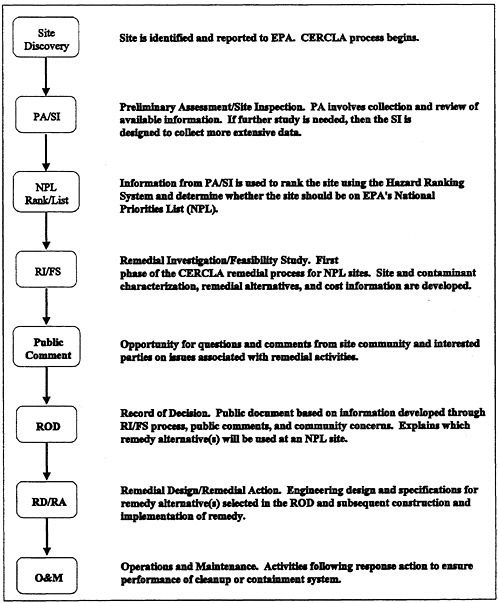
FIGURE 3–3 Steps in the Comprehensive Environmental Response, Compensation, and Liability Act (CERCLA) remedial process. As shown, opportunities for community review of potential remedies occur only after a list of remedial alternatives has been developed. The public’s opportunity to help identify possible alternatives or plan the site evaluation is limited. As shown, the process unfolds sequentially, with little opportunity to go back to earlier stages. Source: NRC (2000).
these procedures are adequate to assess the pathways of exposure and determine the potential risks to designated receptors. However, the committee found that a broader risk-based framework is necessary for PCB-contaminated sediments and that such a framework should encompass all relevant aspects of risk assessment and risk management. It should be able to provide the most effective and acceptable solution to issues related to PCB-contaminated sediments for all potentially affected and involved parties. The framework developed by the Presidential/Congressional Commission on Risk Assessment and Risk Management in its 1997 report Framework for Environmental Health Risk Management (Figure 3–4) was selected by the committee. That decision was made because this framework met all the requirements that the committee found were necessary to assess the risks posed by remediation technologies that may be used for PCB-contaminated sediments.
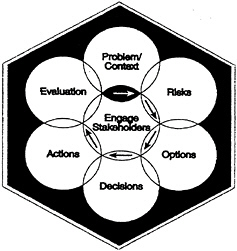
FIGURE 3–4 Commission’s risk-management framework. Source: PCCRARM (1997).
The commission’s framework defines risk management in broader terms than the traditional usage, which is restricted to the process of evaluating alternative regulatory actions and selecting among them. It also places at the center of environmental decision-making, the involvement of all affected parties who might be affected by the risks or required to manage them. The committee believes that a plan that actively engages the affected community or communities as early as possible in the decision-making process and that gives them the resources to participate effectively is a critical component in deciding how to clean up PCB-contaminated sediments. Toward that end, the committee adopted the commission’s framework that places community and stakeholder involvement at the core of the decision-making process. The goal of this process should be to build a partnership and an effective working relationship among the regulatory agencies, site owners, affected community members, and other interested parties (Box 3-1).
The commission’s framework is designed to help all types of risk managers—government officials, private-sector businesses, individual members of the public—make good risk-management decisions. The framework has six stages (Figure 3–4):
|
BOX 3–1 Advantages of the Commission’s Framework
|
-
Define the problem in a public-health and ecological context and establish risk-management goals.
-
Analyze the risks associated with the problem.
-
Examine options for addressing the risks.
-
Make decisions about which options to implement.
-
Take actions to implement the decisions.
-
Conduct an evaluation of the actions’ results.
The framework is conducted as follows:
-
In collaboration with all affected parties.
-
With the use of more than one iteration of the framework if new information becomes available that changes the nature of the problem or the need for risk assessment or risk-management decisions.
The framework involves all affected parties from the earliest problem definition stage through the decision-making and decision-evaluation stages. Affected parties contribute to decision-making, rather than just providing feedback about decisions made by others. The importance of community involvement in all stages of the risk-management process was made clear to the committee at each of its public meetings. However, the committee recognizes that, depending on their situations, affected parties will have differing and often opposing views and goals. In those situations, federal, tribal, state, and local authorities must be given the authority to make decisions.
As indicated in Figure 3–4, the framework involves affected parties through all stages of the process. Note that the stakeholders or affected parties are at the very center of the framework and that the initial problem/context stage is highlighted with a bold overlap and larger arrow in the hexagon in the figure. The framework is designed so that any stage of it may be revisited as appropriate, giving risk managers and the affected public the flexibility to revisit earlier stages of the process when new findings made during later stages shed light on earlier deliberations and decisions. The framework is intended to supplement, not supplant, the CERCLA remedial process mandated by law for Superfund sites.
It is often in the application and interpretation of the results of the assessments that opinions diverge and polemics ensue. These differences of opinion are a function of perspective, mandate, and political and economic goals. The commission’s framework was selected by the committee because it was the most complete and flexible framework and deals with contaminated sediment situations from the identification of the site through risk assessment, implementation of the risk management strategy, and long-term evaluation.
Other frameworks considered by the committee deal primarily with risk assessment, which is critical to the selection of a risk-management strategy and is part of a risk-based framework but not all of it. Although the other frameworks provide for input from parties other than the risk assessor or risk manager, this input is not an integral part of the decision-making process. Furthermore, in each of the frameworks considered by the committee, only health and ecological risks assessments are delineated. Risks such as economic, social, and cultural risks are not considered, nor are risks to humans and ecosystems beyond the immediate problem area. Finally, the other frameworks do not involve an iterative review that includes the risk-reduction goals and management strategy—that is, the other frameworks are linear.
RATIONALE FOR AND ADVANTAGES OF THE FRAMEWORK
The committee understands that the conduct and uses of risk assessment are not without critics. A few of the criticisms that have appeared in the literature (NRC 1994; O’Brien 2000) are cited here, because the committee believes that the commission’s framework is responsive to the concerns raised in these criticisms. The committee emphasizes that our citation of these criticisms does not mean that we believe them to be valid, nor is the order of their listing meant to suggest our opinion regarding their possible importance.
-
Some experts have noted that risk assessment often neglects important aspects of risk, including synergistic interactions from multiple chemical
-
exposures, risk aggregation from combinations of multiple chemicals, individual variability to chemical exposures, and noncancer risks.
-
Some people believe that credible risk assessment might be impossible to obtain with the existing state of science. These people believe that there is not sufficient knowledge about the cancer and noncancer effects caused by exposure to most chemicals to make accurate risk estimates.
-
Some people believe that it is nearly impossible to separate risk assessment (the scientific and objective process of determining hazard, exposure, susceptibility, and risk) from risk management (the procedures used to reduce risks). These people believe that risk assessors typically are hired by those who desire a certain outcome and that risk assessments can be manipulated too easily to favor that outcome.
Those who reject risk assessment may favor alternatives assessment. An alternatives assessment “involves consideration of the pros and cons of a decent range of options” and “includes the public whenever they might be harmed by activities considered in the assessment” (O’Brien 2000). Its method of disclosure and analysis is based on the National Environmental Policy Act (NEPA) regulations, which govern the actions of federal agencies. Alternatives assessment includes risk assessment but relegates risk assessment to looking at the disadvantages of each alternative. If applied to PCB-contaminated sediments, an alternative assessment might include the following elements:
-
Presentation of a full range of options for responding to the PCB-contaminated sediments. The options would include those that seem to promise the least adverse impact on environmental and social health and those that seem to promise the greatest environmental and social advantages.
-
Presentation of the potential adverse and beneficial effects of each alternative. The types of adverse and beneficial consequences considered for each option would vary but might include aesthetic, cultural, economic, and social effects. The presentation would also consider direct, indirect, and cumulative effects.
The public would be involved in “scoping” reasonable alternatives and “commenting” on the presentation and evaluation of their potential beneficial and adverse effects.
The commission’s framework is responsive to the concerns raised by critiques of the risk-assessment process:
-
The framework provides an integrated, holistic approach to solving public-health and environmental problems in context. (It offers a broad vehicle for incorporating all aspects of risk.)
-
The framework ensures that decisions about the use of risk assessment and economic analysis rely on the best scientific evidence and are made in the context of risk-management alternatives. (It focuses on best available science, places risk assessment within the confines of risk-management decision-making, emphasizes consideration of alternatives and recommends peer review of both technical and economic analyses.)
-
The framework allows for evaluation of the pros and cons of remedial alternatives under consideration.
-
The framework emphasizes the importance of collaboration, communication, and negotiation among all affected parties so that public values can influence risk-assessment and risk-management strategies. (It involves active participation by affected parties.) As a result, it should produce risk-based decisions that are more likely to be successful than decisions made without adequate and early involvement of affected parties.
-
The framework accommodates critical new information that might emerge at any stage of the process. (It is iterative.)
The commission’s framework is also general enough to be applicable to a variety of situations, including decisions related to the risk management of PCB-contaminated sediments. As noted in the commission report (PCCRARM 1997), “the level of effort and resources invested in using the Commission’s framework can be scaled to the importance of the problem, potential severity and economic impact of the risk, level of controversy surrounding it, and resource constraints.” This flexibility makes the framework ideal for providing a foundation for the committee’s risk-based approach to managing PCB-contaminated sediments.
No two PCB-contaminated sites are identical; therefore, no one risk management technology or strategy is appropriate for all sites. The affected parties must agree on the risk-management goals, the likely immediate short-term and long-term risks, the available and reasonable risk-management options for consideration, and the pros and cons of the risk-management options. The risks to be considered are those associated with the present PCB contamination, those that might occur while risk management is undertaken, and the short- and long-term risks that remain after risk management has taken place. Every attempt should be made to quantify risks to the extent feasible and in a timely manner, but there will always be some element of value judgment incorporated into the risk assessment.
OUTLINE OF THE RISK-MANAGEMENT FRAMEWORK
The committee refined the commission’s framework as follows for application to the risk management of PCB-contaminated sediments. The commit-
tee’s framework used in concert with the EPA guidance for ecological risk assessment (EPA 1998b) and the Risk Assessment Guidance for Superfund: Human Health Evaluation Manual (EPA 1989) should provide sufficient guidance to perform valid risk assessments of PCB-contaminated sediments that can be used in examining options for risk management of PCB-contaminated sediments.
At the center of the framework is community involvement (Chapter 4), deserving of its own chapter in recognition of the commission’s and the committee’s conclusion that risk management decisions made with adequate and early involvement of affected parties are more likely to be successful than decisions without such involvement. The risk-management framework promotes participation of affected parties at each stage of the risk-assessment and risk-management process.1
The first stage in the framework is defining the problem and setting management goals (Chapter 5). The problem-definition stage is the most important step in application of the risk-management framework, because it characterizes the problem from public health, ecological, social, economic, and cultural perspectives; determines general risk-management goals; and identifies affected parties and decision-makers. These goals may need to be modified as new information is gained about the risks as the site and the best strategy for managing them. Problem characterization should be performed in collaboration with all affected parties.
The intent of managing PCB-contaminated sediments is to reduce present and future risks to human health and the environment from exposure to PCBs. In the problem-definition phase, affected parties are identified, a site assessment is begun, and risk-reduction goals are set. Problem definition should include identification of the perceptions of affected parties (particularly the directly affected community or communities) on the risks posed by the PCB-contaminated sediments problem. Affected parties often propose explicit questions that provide useful guidance for the risk-assessment stage, matters that would be neglected in the standard technical risk assessment (PCCRARM 1997). Involvement of the affected parties in the risk-management framework requires active outreach efforts by the regulatory agencies to engage the affected parties, including the community and industry as partners. This
|
1 |
As noted in Chapter 4, the committee prefers to use the terms “interested” and “affected parties” instead of “stakeholders” in this report, following the guidance of the NRC Committee on Risk Characterization (NRC 1996). The committee makes this distinction to emphasize the need to identify and include the most affected members of the community, some of whom may be the least powerful and most socially disadvantaged. |
involvement must be understood to be a learning process by all affected parties. Furthermore, in many cases, technical assistance might be required to enable the affected parties to participate fully in the risk-management process.
The second stage in the framework is analyzing the risks (Chapter 6). The risk-analysis stage is the risk assessment-risk characterization step of the process in which the specific risks posed by the PCB-contaminated sediments are assessed and placed into their multisource, multimedia, multichemical, and multirisk contexts and in which the gathered information is combined into a characterization of the risk of the PCB-contaminated sediments to humans and the environment.
During the analysis phase, assessment endpoints are selected, conceptual models are developed, and exposure to stressors and the relationship between stressor levels and human and ecological effects are evaluated. Assessment endpoints, specific expressions of the actual value that is to be protected, are the ultimate focus in risk characterization, and act as a link to the risk-management process (such as policy goals). Effect measures or measurement endpoints are responses that might be more easily measured than assessment endpoints but are related quantitatively or qualitatively to the assessment endpoints. The analysis phase involves collection and integration of information on toxicity of the PCBs, PCB concentrations and spatial distribution (at a more detailed level than during the problem-definition stage), and exposure conditions (temporal and spatial patterns), as well as observations or predictions of adverse effects. In the risk-characterization step, risk is estimated through integration of the exposure and stressor-response profiles and is described by lines of evidence for human and ecological effects.
The third stage in the framework is examining management options (Chapter 7). This stage of the risk-management process involves identifying risk-management options and evaluating their effectiveness, feasibility, costs, benefits, unintended consequences, and habitat, cultural and social impacts. In this stage, the pros and cons of an appropriate range of options are considered. Options include socioeconomic and institutional controls, source control, in situ sediment-management technologies, and removal and ex situ storage, disposal, and/or treatment, and natural attenuation. Often a combination of technologies will be needed at a site. Affected parties, particularly the directly affected community or communities, can and should play an important role in all facets of identifying and evaluating options.
The fourth stage in the framework is making a decision (Chapter 8). During this stage of the framework, decision-makers review the information gathered during the analyses of risks and options to select the most appropriate risk management strategy. The strategy selected should be one that actually reduces overall risk, not merely transfers risk to another site or another af-
fected population. The decision-making process necessary to arrive at an optimal management strategy is complex and likely to involve numerous site-specific considerations.
Management decisions must be made, even when information is imperfect. There are uncertainties associated with every decision that need to be weighed, evaluated, and communicated to affected parties. Imperfect knowledge must not become an excuse for not making a decision.
Once again, involving the affected parties is key to a successful outcome. Involving affected parties and incorporating their recommendations where possible reorients the decision-making process from one dominated by regulators and responsible parties to one that includes those who must live with the consequences of the decision. As noted in the commission’s report, this fosters successful implementation.
The fifth stage in the framework is implementing the management strategy (Chapter 9). This stage is crucial to the success of the management strategy. It is important in this step to remember that no two sites are identical, and therefore the risk-management strategy will vary from site to site. It is also important to keep in mind that a single option will rarely suffice at a given site. It is much more common that a combination of options will have to be chosen to reduce the risk due to contamination at a site.
The sixth stage in the framework is evaluating results (Chapter 10). At this stage of risk management, decision-makers and affected parties review what risk-management actions have been implemented and how effective they have been in meeting the management goals established in the first stage. Evaluation of the remedy is an essential part of the process. It is only after the effectiveness of the remedy has been evaluated that the parties can decide whether more actions are needed at the site and whether implementation of the selected options actually accomplished the desired result. As with other stages of the risk-management process, the evaluation will benefit if affected parties are involved. In general, to gain credibility with all affected parties at multiple sites, objective evaluation is needed to ensure that the risk-assessment process and the required investments do generate the protection desired and do so with approximately the financial costs and technical and social complications expected from the action plan. This process is iterative; for instance, a pilot project might be performed to determine the effectiveness of a proposed risk-management option. The process should be sufficiently flexible to assimilate the information as it becomes available, and the actions can be adjusted.
Environmental monitoring—that is, sampling and analysis of environmental media, including biota—during and after the risk-management action is implemented is imperative to evaluate whether the risk-management goals have been met. Failure to achieve the management goals could necessitate a
reexamination of those goals, in addition to selection of new management measures and their commensurate risks. Reviews of ongoing or completed management projects are of great value when planning for future management efforts. The lack of information on past actions can limit management efforts at future sites, particularly when a relatively new remediation technology is being considered for use.
New information might emerge during evaluation that is of sufficient importance to indicate that parts of the framework should be reviewed and repeated. The committee emphasizes that the risk-management process must be iterative and adaptive as important new information, ideas, and perspectives as well as new risk-management options come to light. Each iteration might provide additional certainty and information to support further risk-management decisions, or it might require a course correction. The commission’s risk-management framework provides that flexibility. Each of the stages in the framework, including the need for community involvement in risk management strategy, is discussed in greater detail in the following chapters.
CONCLUSIONS AND RECOMMENDATIONS
Based on the public sessions and the committee’s experience, the following recommendations are made with regard to the selection of a framework for assessing the risks associated with PCB-contaminated sediments and the possible remediation technologies and strategies that may be used at a contaminated site:
-
All risk-management decisions regarding PCB-contaminated sediments should continue to be made within a risk-management framework.
-
All risk-management decisions must include active and continuing involvement from affected parties (particularly the directly affected community or communities) and the use of all available sources of information.
-
The framework should be a refinement of the 1997 Framework for Environmental Health Risk Management developed by the Presidential/ Congressional Commission on Risk Assessment and Risk Management (PCCRARM 1997). The commission’s framework provides for an iterative and collaborative process involving all affected parties. Furthermore, it is applicable to both new contaminated sites and sites where substantial work has already been done. Therefore, when the site evaluation or risk-management process is already under way, the commission’s framework can still be used to reassess available data, involve affected parties, and make, implement, and evaluate management decisions.
REFERENCES
EPA (U.S. Environmental Protection Agency). 1989. Risk Assessment Guidance for Superfund, Volume 1. Human Health Evaluation Manual, Part A. Interim Final. EPA/540/1–89/002. Office of Emergency and Remedial Response, U.S. Environmental Protection Agency, Washington, DC. December. [Online]. Available: http://www.epa.gov/superfund/programs/risk/ragsa/index.htm. (Last updated May 12, 1999).
EPA (U.S. Environmental Protection Agency). 1998a. EPA’s Contaminated Sediment Management Strategy. EPA-823-R-98–001. Office of Water, U.S. Environmental Protection Agency, Washington, DC. April.
EPA (U.S. Environmental Protection Agency). 1998b. Guidelines for Ecological Risk Assessment. Final. EPA-630-R-95–0026F. Risk Assessment Forum, U.S. Environmental Protection Agency, Washington, DC. [Online]. Available: http://www.epa.gov/ncea (Last updated May 03, 1999).
EPA (U.S. Environmental Protection Agency). 1999. Risk Assessment Guidance for Superfund, Vol. 3, Part A. Process for Conducting Probabilistic Risk Assessment. Draft. EPA 000–0–99–000. OSWER 0000.0–000. PB99–000000. Office of Solid Waste and Emergency Response, U.S. Environmental Protection Agency, Washington, DC. December. [Online]. Available: http://www.epa.gov/superfund/pubs.htm.
NRC (National Research Council). 1983. Risk Assessment in the Federal Government: Managing the Process. Washington, DC: National Academy Press. 191pp.
NRC (National Research Council). 1994. Science and Judgment in Risk Assessment. Washington, DC: National Academy Press.
NRC (National Research Council). 1996. Understanding Risk: Informing Decisions in a Democratic Society, P.C.Stern and H.V.Fineberg, eds. Washington, DC: National Academy Press.
NRC (National Research Council). 2000. Natural Attenuation for Groundwater Remediation. Washington, DC: National Academy Press.
O’Brien, M. 2000. Making Better Environmental Decisions, An Alternative to Risk Assessment. Cambridge, MA: The MIT Press.
PCCRARM (Presidential/Congressional Commission on Risk Assessment and Risk Management). 1997. Framework for Environmental Health Risk Management. Vol. 1. Washington, DC: The Commission.

